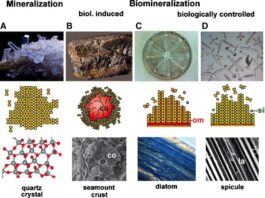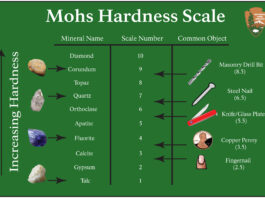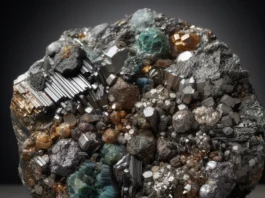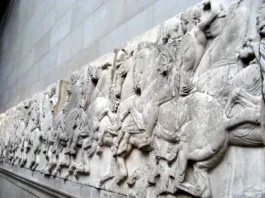The Earth’s structure is a fascinating and complex arrangement of layers that make up our planet’s interior. Understanding this structure is crucial for geologists and scientists as it provides insights into the Earth’s composition, behavior, and the processes that shape our planet. This knowledge is also essential for various fields, including geology, seismology, and plate tectonics, as it helps explain natural phenomena like earthquakes, volcanoes, and the formation of continents and ocean basins.

Contents
- Interior of the Earth: Crust, Mantle and Core
- What should you understand about the interior of the earth?
- Sources of Information about the interior of the earth
- Structure of the earth’s interior
- Crust
- Mantle
- Core
- Composition of Earth
- Temperature, Pressure and Density of the Earth’s Interior
- Temperature
- Pressure
- Density
- Earth’s Magnetic Field
- References
Interior of the Earth: Crust, Mantle and Core
The Earth’s interior can be divided into three main layers: the crust, the mantle, and the core. These layers have distinct properties and compositions, which play a significant role in shaping our planet’s geology and behavior.
- Crust:
- The Earth’s crust is the outermost layer and the one we interact with directly. It varies in thickness, with oceanic crust being thinner (about 4-7 miles or 6-11 kilometers) and continental crust being thicker (averaging about 19 miles or 30 kilometers).
- The crust is primarily composed of solid rock, with different types of rock prevailing in continental and oceanic regions. Continental crust is mostly made up of granitic rocks, while oceanic crust is primarily composed of basaltic rocks.
- The Earth’s crust is where we find the Earth’s landforms, such as mountains, valleys, and plains, as well as the ocean floor.
- Mantle:
- The mantle is located beneath the Earth’s crust and extends to a depth of about 1,800 miles (2,900 kilometers). It is the thickest layer of the Earth.
- The mantle is composed of solid rock, primarily silicate minerals. Although it is solid, the mantle behaves like a very viscous or plastic material over geological timescales. This property allows the mantle to flow slowly, leading to the movement of tectonic plates and the associated geological phenomena like earthquakes and volcanoes.
- The heat generated from the Earth’s interior and the decay of radioactive elements contribute to the high temperatures within the mantle.
- Core:
- The Earth’s core is divided into two parts: the outer core and the inner core.
- Outer Core:
- The outer core is located beneath the mantle, beginning at a depth of about 1,800 miles (2,900 kilometers) and extending to around 3,500 kilometers below the surface.
- It is primarily composed of molten iron and nickel. The high temperatures and pressures in the outer core keep these materials in a liquid state.
- The motion of molten iron in the outer core is responsible for generating the Earth’s magnetic field through the geodynamo process.
- Inner Core:
- The inner core is situated at the very center of the Earth, starting at a depth of about 3,500 kilometers.
- It is primarily composed of solid iron and nickel. Despite the extremely high temperatures at this depth, the inner core remains solid due to the tremendous pressure.
- The inner core’s solid nature is important for understanding the Earth’s internal dynamics, including how seismic waves pass through it.
The Earth’s structure and the interactions between these layers are responsible for various geological phenomena, including earthquakes, volcanic eruptions, and the movement of tectonic plates. The knowledge of the Earth’s interior structure is crucial for understanding and predicting these natural events, as well as for exploring the planet’s history and geology.
What should you understand about the interior of the earth?
- It is not possible to know about the earth’s interior by direct observations because of the huge size and the changing nature of its interior composition.
- It is an almost impossible distance for the humans to reach till the centre of the earth (The earth’s radius is 6,370 km).
- Through mining and drilling operations we have been able to observe the earth’s interior directly only up to a depth of few kilometers.
- The rapid increase in temperature below the earth’s surface is mainly responsible for setting a limit to direct observations inside the earth.
- But still, through some direct and indirect sources, the scientists have a fair idea about how the earth’s interior look like.
Sources of Information about the interior of the earth
Direct Sources:
- Rocks from mining area
- Volcanic eruptions
Indirect Sources
- By analyzing the rate of change of temperature and pressure from the surface towards the interior.
- Meteors, as they belong to the same type of materials earth is made of.
- Gravitation, which is greater near poles and less at the equator.
- Gravity anomaly, which is the change in gravity value according to the mass of material, gives us information about the materials in the earth’s interior.
- Magnetic sources.
- Seismic Waves: the shadow zones of body waves (Primary and secondary waves) give us information about the state of materials in the interior.
Structure of the earth’s interior

Structure of earth’s interior is fundamentally divided into three layers – crust, mantle and core.
Crust
- It is the outermost solid part of the earth, normally about 8-40 kms thick.
- It is brittle in nature.
- Nearly 1% of the earth’s volume and 0.5% of earth’s mass are made of the crust.
- The thickness of the crust under the oceanic and continental areas are different. Oceanic crust is thinner (about 5kms) as compared to the continental crust (about 30kms).
- Major constituent elements of crust are Silica (Si) and Aluminium (Al) and thus, it is often termed as SIAL (Sometimes SIAL is used to refer Lithosphere, which is the region comprising the crust and uppermost solid mantle, also).
- The mean density of the materials in the crust is 3g/cm3.
- The discontinuity between the hydrosphere and crust is termed as the Conrad Discontinuity.

Mantle
- The portion of the interior beyond the crust is called as the mantle.
- The discontinuity between the crust and mantle is called as the Mohorovich Discontinuity or Moho discontinuity.
- The mantle is about 2900kms in thickness.
- Nearly 84% of the earth’s volume and 67% of the earth’s mass is occupied by the mantle.
- The major constituent elements of the mantle are Silicon and Magnesium and hence it is also termed as SIMA.
- The density of the layer is higher than the crust and varies from 3.3 – 5.4g/cm3.
- The uppermost solid part of the mantle and the entire crust constitute the Lithosphere.
- The asthenosphere (in between 80-200km) is a highly viscous, mechanically weak and ductile, deforming region of the upper mantle which lies just below the lithosphere.
- The asthenosphere is the main source of magma and it is the layer over which the lithospheric plates/ continental plates move (plate tectonics).
- The discontinuity between the upper mantle and the lower mantle is known as Repetti Discontinuity.
- The portion of the mantle which is just below the lithosphere and asthenosphere, but above the core is called as Mesosphere.
Core
- It is the innermost layer surrounding the earth’s centre.
- The core is separated from the mantle by Guttenberg’s Discontinuity.
- It is composed mainly of iron (Fe) and nickel (Ni) and hence it is also called as NIFE.
- The core constitutes nearly 15% of earth’s volume and 32.5% of earth’s mass.
- The core is the densest layer of the earth with its density ranges between 9.5-14.5g/cm3.
- The Core consists of two sub-layers: the inner core and the outer core.
- The inner core is in solid state and the outer core is in the liquid state (or semi-liquid).
- The discontinuity between the upper core and the lower core is called as Lehmann Discontinuity.
- Barysphere is sometimes used to refer the core of the earth or sometimes the whole interior.
Composition of Earth
Major Elements and Minerals in Earth’s Composition:
- Oxygen (O): Oxygen is the most abundant element in Earth’s composition, making up approximately 46.6% of the Earth’s crust by weight. It is a crucial component of minerals and compounds, such as silicates and oxides.
- Silicon (Si): Silicon is the second most abundant element in the Earth’s crust, accounting for about 27.7% of its composition. It is a key component in various silicate minerals, which are the primary building blocks of the Earth’s crust.
- Aluminum (Al): Aluminum makes up around 8.1% of the Earth’s crust. It is often found in minerals like feldspar, bauxite, and various silicates.
- Iron (Fe): Iron is another essential element in Earth’s composition, constituting approximately 5% of the Earth’s crust. It is found in various minerals, including hematite and magnetite.
- Calcium (Ca): Calcium makes up about 3.6% of the Earth’s crust and is commonly found in minerals like calcite and gypsum.
- Sodium (Na) and Potassium (K): Sodium and potassium together account for around 2.8% of the Earth’s crust. These elements are typically found in minerals like feldspar.
- Magnesium (Mg): Magnesium constitutes about 2.1% of the Earth’s crust and is found in minerals such as olivine and serpentine.
- Titanium (Ti): Titanium makes up approximately 0.57% of the Earth’s crust and is present in minerals like ilmenite and rutile.
- Hydrogen (H): While hydrogen is not a major component of the Earth’s crust, it is a significant element in the Earth’s overall composition, mainly in the form of water (H2O).
- Other Elements: Various other elements, including sulfur, carbon, phosphorus, and many trace elements, are present in smaller amounts in the Earth’s composition.
Distribution of Elements Within Earth’s Layers:
- Crust: The Earth’s crust is primarily composed of silicate minerals, including quartz, feldspar, mica, and various types of rock. Silicon and oxygen are the most abundant elements in the crust, forming the backbone of these minerals.
- Mantle: The mantle is composed mainly of silicate minerals, with iron and magnesium as dominant elements. Olivine, pyroxenes, and garnet are common minerals found in the mantle.
- Outer Core: The outer core is primarily composed of liquid iron and nickel. This layer is responsible for generating Earth’s magnetic field, with iron being the dominant element.
- Inner Core: The inner core is composed of solid iron and nickel. Despite the extremely high temperatures, the intense pressure keeps these elements in a solid state.
The distribution of elements within Earth’s layers is a result of the differentiation and separation of materials during the Earth’s early history. The layered structure of the Earth is a consequence of the physical and chemical processes that have occurred over billions of years, including planetary accretion, differentiation, and geological activity.
Temperature, Pressure and Density of the Earth’s Interior
Temperature
- A rise in temperature with increase in depth is observed in mines and deep wells.
- These evidence along with molten lava erupted from the earth’s interior supports that the temperature increases towards the centre of the earth.
- The different observations show that the rate of increase of temperature is not uniform from the surface towards the earth’s centre. It is faster at some places and slower at other places.
- In the beginning, this rate of increase of temperature is at an average rate of 1C for every 32m increase in depth.
- While in the upper 100kms, the increase in temperature is at the rate of 12C per km and in the next 300kms, it is 20C per km. But going further deep, this rate reduces to mere 10C per km.
- Thus, it is assumed that the rate of increase of temperature beneath the surface is decreasing towards the centre (do not confuse rate of increase of temperature with increase of temperature. Temperature is always increasing from the earth’s surface towards the centre).
- The temperature at the centre is estimated to lie somewhere between 3000C and 5000C, may be that much higher due to the chemical reactions under high-pressure conditions.
- Even in such a high temperature also, the materials at the centre of the earth are in solid state because of the heavy pressure of the overlying materials.
Pressure
- Just like the temperature, the pressure is also increasing from the surface towards the centre of the earth.
- It is due to the huge weight of the overlying materials like rocks.
- It is estimated that in the deeper portions, the pressure is tremendously high which will be nearly 3 to 4 million times more than the pressure of the atmosphere at sea level.
- At high temperature, the materials beneath will melt towards the centre part of the earth but due to heavy pressure, these molten materials acquire the properties of a solid and are probably in a plastic state.
Density
- Due to increase in pressure and presence of heavier materials like Nickel and Iron towards the centre, the density of earth’s layers also gets on increasing towards the centre.
- The average density of the layers gets on increasing from crust to core and it is nearly 14.5g/cm3 at the very centre.
Earth’s Magnetic Field
Earth’s magnetic field is a crucial and complex feature that surrounds our planet. It plays a significant role in our daily lives and has several important functions. Here’s an overview of Earth’s magnetic field:
1. Generation of Earth’s Magnetic Field:
- Earth’s magnetic field is primarily generated by the movement of molten iron and nickel in the outer core of the planet. This process is known as the geodynamo.
- The geodynamo is driven by the heat generated from the decay of radioactive isotopes in the Earth’s interior and the cooling of the core.
2. Magnetic Polarity:
- Earth’s magnetic field has a north and south magnetic pole, similar to a bar magnet. However, these magnetic poles are not aligned with the geographic North and South Poles.
- The positions and orientations of Earth’s magnetic poles can change over geological time, and these reversals in polarity are recorded in rocks as “magnetic striping.”
3. Magnetic Field Components:
- Earth’s magnetic field is characterized by its strength, inclination, and declination.
- Magnetic Strength: This represents the intensity of the magnetic field at a specific location on Earth’s surface.
- Inclination: It refers to the angle at which the magnetic field lines intersect the Earth’s surface, varying from near-vertical at the magnetic poles to horizontal at the equator.
- Declination: This is the angle between true north (geographic north) and magnetic north.
4. Magnetic Field Function and Importance:
- The Earth’s magnetic field has several important functions and benefits:
- It serves as a protective shield, deflecting harmful charged particles from the Sun, such as solar wind and cosmic rays. This shield is known as the magnetosphere and helps protect the atmosphere and life on Earth.
- It enables navigation and orientation for migratory animals, including birds and sea turtles, that use the magnetic field as a compass.
- Compasses rely on Earth’s magnetic field for navigation and orientation.
- The magnetic field is used in various scientific and geological studies, including paleomagnetism (the study of ancient magnetic fields recorded in rocks) to understand Earth’s history and the movement of tectonic plates.
- The magnetic field is essential for modern technology, including magnetic resonance imaging (MRI) in medicine and various applications in geophysical exploration.
5. Changes in Earth’s Magnetic Field:
- The Earth’s magnetic field is not constant and can undergo changes over time, including secular variation (gradual changes) and geomagnetic reversals (flips in magnetic polarity).
- Researchers monitor these changes, and recent observations have shown that the magnetic North Pole is shifting at a faster rate than in the past.
Understanding Earth’s magnetic field is essential for various scientific, technological, and environmental reasons. It is an integral part of the planet’s geology and plays a vital role in maintaining the conditions necessary for life on Earth.
References
Jijo Sudarsan ,Interior of the Earth: Crust, Mantle and Core(2018),https://www.clearias.com/interior-of-the-earth/






